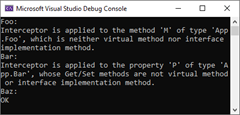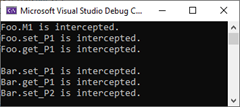 在Dora.Interception(github地址,觉得不错不妨给一颗星)中按照约定方式定义的拦截器可以采用多种方式注册到目标方法上。本篇文章介绍最常用的基于“特性标注”的拦截器注册方式,下一篇会介绍另一种基于(Lambda)表达式的注册方式。如果原生定义的这两种注册方式不能满足要求,利用框架提供的扩展,我们可以完成任何你想要的拦截器注册手段。(
在Dora.Interception(github地址,觉得不错不妨给一颗星)中按照约定方式定义的拦截器可以采用多种方式注册到目标方法上。本篇文章介绍最常用的基于“特性标注”的拦截器注册方式,下一篇会介绍另一种基于(Lambda)表达式的注册方式。如果原生定义的这两种注册方式不能满足要求,利用框架提供的扩展,我们可以完成任何你想要的拦截器注册手段。(
在Dora.Interception(github地址,觉得不错不妨给一颗星)中按照约定方式定义的拦截器可以采用多种方式注册到目标方法上。本篇文章介绍最常用的基于“特性标注”的拦截器注册方式,下一篇会介绍另一种基于(Lambda)表达式的注册方式。如果原生定义的这两种注册方式不能满足要求,利用框架提供的扩展,我们可以完成任何你想要的拦截器注册手段。(拙著《ASP.NET Core 6框架揭秘》于日前上市,加入读者群享6折优惠)
一、InterceptorAttribute 特性目录
一、InterceptorAttribute 特性
二、指定构造拦截器的参数列表
三、将拦截器类型定义成特性
四、合法性检验
五、针对类型、属性的标注
六、拦截的屏蔽
拦截器类型可以利用如下这个InterceptorAttribute特性应用到标注的类型、属性和方法上。除了通过Interceptor属性指定拦截器类型之外,我们还可以利用Order属性控制拦截器的执行顺序,该属性默认值为0。该特性的Arguments用来提供构造拦截器对象的参数。
[AttributeUsage(AttributeTargets.Class | AttributeTargets.Method | AttributeTargets.Property, AllowMultiple = true, Inherited = false)] public class InterceptorAttribute : Attribute { public Type Interceptor { get; } public object[] Arguments { get; } public int Order { get; set; } public InterceptorAttribute(params object[] arguments) : public InterceptorAttribute(Type? interceptor, params object[] arguments); }二、指定构造拦截器的参数列表
拦截器对象是通过依赖注入容器提供的,容器能够自动提供注入到构造函数中对象。如果构造函数包含额外的参数,对应的参数值就需要利用InterceptorAttribute 特性的Arguments属性来提供,此属性由构造函数的arguments参数提供。
public class FoobarInterceptor { public string Name { get; } public FoobarInterceptor(string name, IFoobar foobar) { Name = name; Debug.Assert(foobar is not null); } public ValueTask InvokeAsync(InvocationContext invocationContext) { Console.WriteLine($"FoobarInterceptor '{Name}' is invoked."); return invocationContext.ProceedAsync(); } } public interface IFoobar { } public class Foobar : IFoobar { }
对于如上这个拦截器类型FoobarInterceptor,其构造函数定义了一个字符串的参数name用来指定拦截器的名称,当我利用InterceptorAttribute 特性将此拦截器应用到Invoker类型的Invoke1和Invoke2方法上是,就需要按照如下的方式指定具体的名称(Interceptor1和Interceptor2)。
public class Invoker { [FoobarInterceptor("Interceptor1")] public virtual void Invoke1() => Console.WriteLine("Invoker.Invoke1()"); [FoobarInterceptor("Interceptor2")] public virtual void Invoke2() => Console.WriteLine("Invoker.Invoke2()"); }
我们按照如下的方式调用Invoker对象的Invoke1和Invoke2方法。
var invoker = new ServiceCollection()
.AddSingleton<Invoker>()
.AddSingleton<IFoobar, Foobar>()
.BuildInterceptableServiceProvider()
.GetRequiredService<Invoker>();
invoker.Invoke1();
invoker.Invoke2();程序执行后,拦截器会以如下的形式将自身的名称输出到控制台上(源代码)。

其实我们可以让定义的拦截器类型派生于InterceptorAttribute 特性,这样就可以直接将它标注到目标类型、属性和方法上。比如上面这个FoobarInterceptor类型可以改写成如下的形式。
public class FoobarInterceptorAttribute: InterceptorAttribute { public string Name { get; } public FoobarInterceptorAttribute(string name) => Name = name; public ValueTask InvokeAsync(InvocationContext invocationContext) { Console.WriteLine($"FoobarInterceptor '{Name}' is invoked."); return invocationContext.ProceedAsync(); } }
那么它就可以按照如下的方式标注到Invoker类型的两个方法上(源代码)。
public class Invoker { [FoobarInterceptor("Interceptor1")] public virtual void Invoke1() => Console.WriteLine("Invoker.Invoke1()"); [FoobarInterceptor("Interceptor2")] public virtual void Invoke2() => Console.WriteLine("Invoker.Invoke2()"); }四、合法性检验
只有接口方法和虚方法才能被拦截,Dora.Interception针对拦截器的应用提供了如下的验证逻辑:
- 标注到方法上(函数属性的Get/Set方法):如果目标方法均不能被拦截,抛出异常;
- 标注到属性上:表示将拦截器应用到该属性可以被拦截的Get/Set方法上。如果Get和Set方法均不能被拦截,抛出异常;
- 标注到类型上:表示将拦截器应用到目标类型可以来拦截的方法(含属性方法)上,如果类型的所有方法均不能被拦截,此时不会抛出异常。
public class Foo { [FoobarInterceptor] public void M() { } } public class Bar { [FoobarInterceptor] public object? P { get; set; } } [FoobarInterceptor] public class Baz { public void M() { } }
对于上面定义的三个类型,Foo的M方法和Bar的P属性均是无法被拦截,Baz类型并没有可以被拦截的方法。我们采用如下的程序测试上述的检验逻辑。
GetService<Foo>(); GetService<Bar>(); GetService<Baz>(); static void GetService<T>() where T:class { try { Console.WriteLine($"{typeof(T).Name}:"); _ = new ServiceCollection() .AddSingleton<T>() .BuildInterceptableServiceProvider() .GetRequiredService<T>(); Console.WriteLine("OK"); } catch (Exception ex) { Console.WriteLine(ex.Message); } }
程序运行后会在控制台上输出如下的结果,可以看出只有将拦截器应用到不合法的方法和属性上才会抛出异常(源代码)。

我们利用如下这个拦截器类型FoobarInterceptorAttribute 来演示将拦截器应用到类型和属性上。该拦截器类型派生于InterceptorAttribute特性,并在执行的时候输出当前的方法。
public class FoobarInterceptorAttribute : InterceptorAttribute { public ValueTask InvokeAsync(InvocationContext invocationContext) { var method = invocationContext.MethodInfo; Console.WriteLine($"{method.DeclaringType!.Name}.{method.Name} is intercepted."); return invocationContext.ProceedAsync(); } }
我们将FoobarInterceptorAttribute 特性标注到Foo类型上,后者定义的M1方法和P1属性是可以被拦截的,但是M2方法和P2属性则不能。FoobarInterceptorAttribute 特性还被应用到Bar类型的P1属性以及P2属性的Set方法上。
[FoobarInterceptor] public class Foo { public virtual void M1() { } public void M2() { } public virtual object? P1 { get; set; } public object? P2 { get; set; } } public class Bar { [FoobarInterceptor] public virtual object? P1 { get; set; } public virtual object? P2 { get; [FoobarInterceptor] set; } }
我们利用如下的程序来检验针对Foo和Bar对象所有方法和属性的调用,那么被拦截器拦截下来。
var provider = new ServiceCollection() .AddSingleton<Foo>() .AddSingleton<Bar>() .BuildInterceptableServiceProvider(); var foo = provider.GetRequiredService<Foo>(); var bar = provider.GetRequiredService<Bar>(); foo.M1(); foo.M2(); foo.P1 = null; _ = foo.P1; foo.P2 = null; _ = foo.P2; Console.WriteLine(); bar.P1 = null; _ = bar.P1; bar.P2 = null; _ = bar.P2;
程序运行之后会在控制台上输出如下的结果(源代码)。

如果某个拦截器需要被应用大某个类型的绝大部分成员,我们可以选择“排除法”:将拦截器应用到该类型上,将某些非目标成员屏蔽掉。还有一种情况下,如果我们确定某些类型或者方法不能被拦截(比如会在一个循环中频繁调用),又担心一些“模糊”的拦截器注册方法将它们与某些拦截器错误地关联在一起,此时我们可以选择将其拦截功能显式屏蔽掉。
针对拦截的屏蔽可以通过在类型、属性、方法设置程序集上标注NonInterceptableAttribute特性。由于屏蔽功能具有最高优先级,一旦将此特性应用到某个类型上,该类型上的所有成员均不会被拦截。如果被标注到属性上,其Get和Set方法也不会被拦截。具有如下定义的Foo和Bar类型的所有方法和属性都不会被拦截(源代码)。
[FoobarInterceptor] public class Foo { [NonInterceptable] public virtual void M() { } [NonInterceptable] public virtual object? P1 { get; set; } public virtual object? P2 { [NonInterceptable] get; set; } } [NonInterceptable] public class Bar { [FoobarInterceptor] public virtual void M() { } [FoobarInterceptor] public virtual object? P { get; set; } }
全新升级的AOP框架Dora.Interception[1]: 编程体验
全新升级的AOP框架Dora.Interception[2]: 基于约定的拦截器定义方式
全新升级的AOP框架Dora.Interception[3]: 基于“特性标注”的拦截器注册方式
全新升级的AOP框架Dora.Interception[4]: 基于“Lambda表达式”的拦截器注册方式
全新升级的AOP框架Dora.Interception[5]: 实现任意的拦截器注册方式
全新升级的AOP框架Dora.Interception[6]: 框架设计和实现原理
